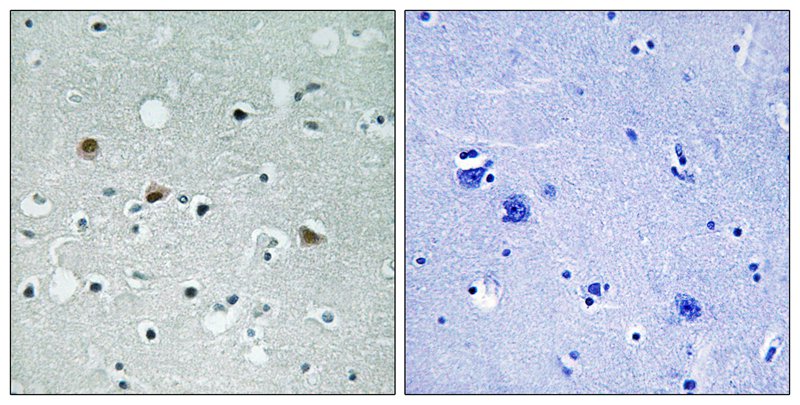
| WB | 咨询技术 | Human,Mouse,Rat |
| IF | 咨询技术 | Human,Mouse,Rat |
| IHC | 1/50-1/100 | Human,Mouse,Rat |
| ICC | 技术咨询 | Human,Mouse,Rat |
| FCM | 咨询技术 | Human,Mouse,Rat |
| Elisa | 咨询技术 | Human,Mouse,Rat |
| Aliases | WARTS; Large tumor suppressor 1; EC 2.7.11.1; |
| Entrez GeneID | 9113; |
| WB Predicted band size | 126kDa |
| Host/Isotype | Rabbit IgG |
| Antibody Type | Primary antibody |
| Storage | Store at 4°C short term. Aliquot and store at -20°C long term. Avoid freeze/thaw cycles. |
| Species Reactivity | Human,Mouse |
| Immunogen | Peptide sequence around phosphorylation site of threonine 1079/1041 (E-F-T(p)-F-R) derived from Human LATS1/2 . |
| Formulation | Purified antibody in PBS with 0.05% sodium azide. |
+ +
以下是关于LATS1/2 (Phospho-Thr1079/1041)抗体的3篇参考文献示例(注:具体文献可能需要根据实际使用情况调整,建议通过抗体供应商或数据库进一步验证):
---
1. **文献名称**: **"Inactivation of YAP Oncoprotein by the Hippo Pathway is Involved in Cell Contact Inhibition and Tissue Growth Control"**
**作者**: Zhao, B. et al.
**摘要**: 本研究揭示了Hippo通路中LATS1/2通过磷酸化YAP抑制其活性的机制。作者使用针对LATS1 (Phospho-Thr1079)的抗体,验证了细胞密度增加时LATS1的激活状态,并证明其磷酸化对YAP的核质转运起关键作用。
---
2. **文献名称**: **"Regulation of the Hippo-YAP Pathway by G-Protein-Coupled Receptor Signaling"**
**作者**: Yu, F.X. et al.
**摘要**: 该研究探讨GPCR信号如何通过调控Hippo通路影响YAP/TAZ活性。实验中采用LATS1/2 (Phospho-Thr1079/1041)特异性抗体,证实了LATS激酶在GPCR激活后的磷酸化变化及其与YAP抑制的关联。
---
3. **文献名称**: **"The Hippo Pathway Effectors YAP and TAZ Promote Cell Growth by Modulating EGFR Signaling"**
**作者**: Fan, R. et al.
**摘要**: 本文发现YAP/TAZ通过调控EGFR信号促进细胞增殖,并利用LATS2 (Phospho-Thr1041)抗体证明生长因子刺激可抑制LATS2活性,从而解除对YAP的磷酸化抑制,支持其核定位。
---
**提示**:若需具体文献,可访问抗体供应商(如CST #13646)的产品页面,查看其引用的研究;或在PubMed中以关键词“LATS1 Phospho-Thr1079”或“LATS2 Phospho-Thr1041”筛选近年论文。
The LATS1/2 (Phospho-Thr1079/1041) antibody detects the phosphorylated forms of Large Tumor Suppressor Kinases 1 and 2 (LATS1/2) at specific threonine residues (Thr1079 in LATS1. Thr1041 in LATS2). These kinases are core components of the Hippo signaling pathway, a conserved regulator of organ size, cell proliferation, apoptosis, and stem cell maintenance. Phosphorylation at these sites is critical for LATS1/2 activation, which occurs upstream via MST1/2 kinases. Activated LATS1/2 phosphorylate downstream effectors like YAP (Yes-associated protein) and TAZ (Transcriptional coactivator with PDZ-binding motif), promoting their cytoplasmic retention and degradation, thereby inhibiting their pro-growth transcriptional activity.
This antibody is widely used to study Hippo pathway activity in contexts such as cancer, tissue homeostasis, and development. Dysregulation of LATS1/2 phosphorylation is linked to tumorigenesis, as loss of Hippo signaling leads to unchecked YAP/TAZ-driven proliferation. Researchers employ the antibody in techniques like Western blotting, immunofluorescence, and immunoprecipitation to assess pathway activation status, evaluate therapeutic responses, or explore mechanistic interactions in cellular and animal models. Its specificity for the activated state makes it a valuable tool for probing Hippo-related physiological or pathological processes.
×